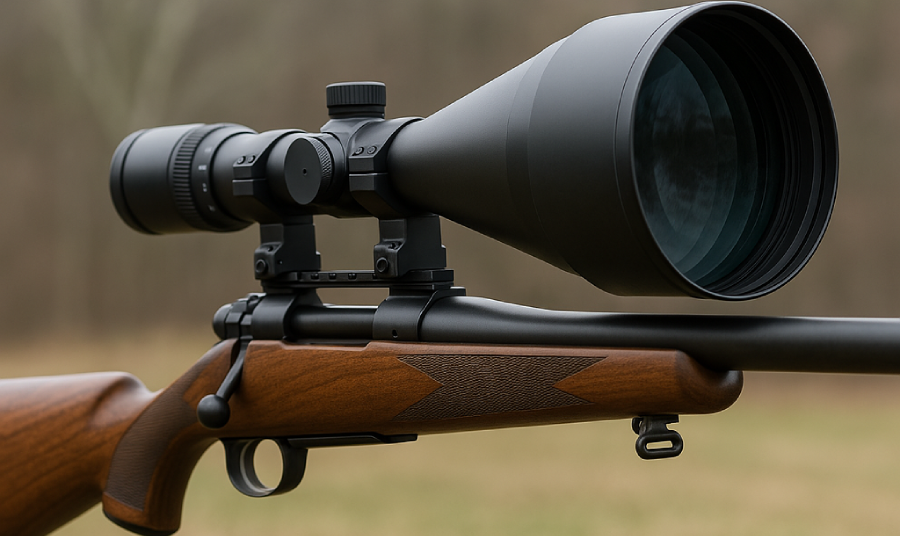Nope. Not even close. If you've ever tried slapping a random scope onto your rifle and hoped for the best, you probably learned the hard way that mounting optics is more complicated than just screwing things together. Different rifles have different mounting systems, and different scopes have different requirements.
Rails, Rings, and Mounting Systems for Riflescopes
The first major hurdle is your rifle’s mounting system. Most new rifles come with a Picatinny rail, which is the modern standard for mounting just about anything with a rail clamp. It offers a universal design with evenly spaced slots, meaning you can easily swap optics between rifles as long as they both use the same system. Weaver rails look similar but have different slot spacing, which can be a problem depending on your scope rings or mount.
Then you’ve got dovetail mounts. These are a bit more old-school and show up on rimfire rifles, airguns, and some milsurp firearms, especially those from Warsaw Pact nations. However, dovetails have no standardization, which means that not all dovetail-mounted scopes will fit all dovetail rails. Worse yet, there’s no universal dovetail size, so a 3/8” dovetail might not work with an 11mm dovetail scope ring. You need to match the sizes exactly.
If your rifle lacks a rail altogether, things get tricky. Some old bolt-action rifles rely on drilled-and-tapped receiver holes for specific scope bases, and if those bases don’t exist or aren’t available anymore, you’re out of luck unless you want to pay for some serious gunsmithing.
Eye Relief and Scope Positioning: Why It Matters
Let’s say you’ve got the right rail or mounting system. Does that mean your scope will work? Not necessarily. Eye relief—the distance between your eye and the scope—varies widely depending on the optic. Traditional riflescopes usually have an eye relief of 3-4 inches, which means they need to be mounted relatively close to your face for a full sight picture. However, every person's ideal eye positioning is unique, and if you mount one too far forward (such as on a rifle with a long action or a forward-mounted rail), you might struggle to see anything at all.

Then there are scout scopes. These have significantly longer eye relief, often 8-12 inches, so they can be mounted forward on a rifle, usually just ahead of the receiver. This setup is great for certain rifles, especially milsurp bolt actions that don’t have a traditional scope mounting location. If you try mounting a standard scope in a scout position, though, you’ll just end up with a useless black void in your sight picture.
Cantilever Mounts, Ring Height, and Height Over Bore
So now you've got the right rail and the right eye relief. But what about height? If you’re using an AR-pattern rifle, you’ll often need a cantilever mount to push the scope forward and raise it to the correct height for a comfortable cheek weld. A cheek weld is the consistent positioning of your cheek against the stock of your rifle, which is crucial for maintaining accuracy and repeatability in shooting. A proper cheek weld ensures that your eye aligns perfectly with the scope each time you take a shot, reducing inconsistencies in aim and improving overall stability. For some, standard scope rings might not cut it for ARs because they sit too low, forcing you to crane your neck down to an awkward position.
Height over bore is another important consideration. This refers to the vertical distance between the center of your rifle’s bore and the center of your scope’s optic. The further your scope sits from the bore, the more pronounced your holdovers and ballistic compensation need to be. Holdovers refer to aiming adjustments made by raising or lowering the reticle to compensate for bullet drop at different distances, while ballistic compensation accounts for various external factors such as wind, gravity, and bullet velocity to ensure accurate shot placement. This can be especially problematic for precision shooting or when using large-objective scopes that force your optic even higher.
Big Objective Bells and Their Challenges
Speaking of large objectives, let’s talk about those monster 50mm+ objective lenses. Sure, they gather more light, which is great for low-light shooting, but they also require higher scope rings to clear the barrel. That means a higher height-over-bore issue, a different cheek weld, and potentially a harder time getting a comfortable sight picture.
For some rifles, this is no problem, but for others—especially classic hunting rifles designed around low-mounted scopes—it can make getting a consistent cheek weld difficult. Fortunately, you can get around this problem with cheek risers on your buttstock. Cheek risers help raise your head to the proper height, allowing for better alignment with your optic and improving overall shooting comfort.
Older MilSurp Rifles: Unique Scope Mounting Hurdles
If you're trying to scope an old military surplus rifle, prepare for a challenge. Many were never designed for optics and lack the necessary mounting points. Some, like old Mausers and Mosin-Nagants, require drilling and tapping, specialized side-mounts, and sometimes even bending your bolt handle, while others, like the M1 Garand, are borderline impossible to scope without serious modifications.
For these rifles, scout scopes are often the best (and sometimes only) option, as they allow forward mounting without requiring permanent alterations. But again, that only works if you have a long-eye-relief scope in the first place.
So, Can Any Scope Fit on Any Rifle?
No. Different mounting systems, eye relief needs, scope heights, and rifle designs all play a role in compatibility. Before buying a scope, make sure it matches your rifle’s rail system, sits at a comfortable height, and has the correct eye relief for how it will be mounted. Otherwise, you might end up with a very expensive paperweight instead of a functional optic.
Got questions about mounting your Sightmark optic? Drop us a comment or check out our lineup of riflescopes and mounts for the best fit.
Frequently Asked Questions
What are the different mounting systems for riflescopes?
There are Picatinny rails, Weaver rails, and dovetail mounts commonly used for mounting riflescopes.
Are all mounting systems universal?
No, different mounting systems have varying slot spacing and sizes, so not all scopes will fit all rails.
Why is eye relief important when mounting a scope?
Eye relief determines the distance between your eye and the scope, affecting your ability to see through the optic clearly.
What are scout scopes and how do they differ from traditional scopes?
Scout scopes have longer eye relief and are designed to be mounted forward on a rifle, usually ahead of the receiver, making them suitable for certain rifles without traditional scope mounting locations.
What is a cantilever mount used for?
A cantilever mount is often used on AR-pattern rifles to push the scope forward and raise it to the correct height for a comfortable cheek weld.
Why is it important to match the height of the scope with the rifle?
Matching the height of the scope with the rifle ensures a comfortable cheek weld, which is essential for consistent shooting accuracy.




